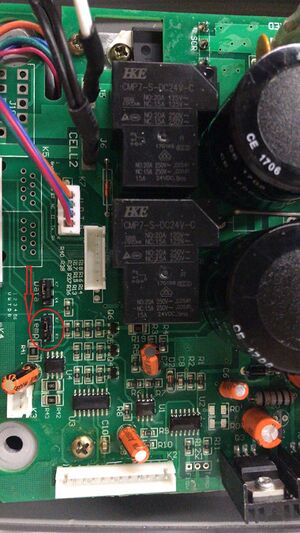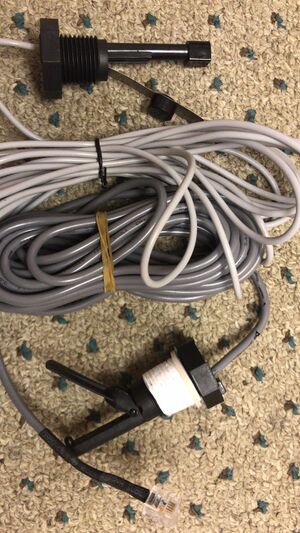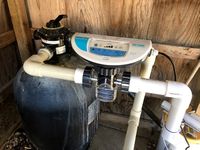m |
|||
| Line 1: | Line 1: | ||
| + | [[Category:Swimming Pool Equipment]] | ||
| + | |||
=Circupool SWG= | =Circupool SWG= | ||
Circupool is a popular SWG brand due to their competitive pricing and warranty allowing DIY installation. Reports are they also have good tech support and the office is staffed by cordial, friendly people.<ref>https://www.troublefreepool.com/threads/circupool-rj-review.184304/post-1626661</ref> | Circupool is a popular SWG brand due to their competitive pricing and warranty allowing DIY installation. Reports are they also have good tech support and the office is staffed by cordial, friendly people.<ref>https://www.troublefreepool.com/threads/circupool-rj-review.184304/post-1626661</ref> | ||
Revision as of 23:01, 4 October 2021
Circupool SWG
Circupool is a popular SWG brand due to their competitive pricing and warranty allowing DIY installation. Reports are they also have good tech support and the office is staffed by cordial, friendly people.[1]
Note all gallons and chlorine output below assume the cell is running at 100% 24/7.
Circupool may include a sticker that says "10 PSI max". That is not your filter pressure. They are talking about a differential pressure between the input to the cell and the output of the cell. Since one side of the cell is basically the pool, you will not see anything close to 10 lbs.[2] The only situation where the pressure in a cell would be higher than 10 psi is if you have an in-floor cleaning system.
SJ Series
- The SJ is a basic model with only 25% increments for % generation.[3] That may not provide fine enough % control if you get an oversize cell. You will need to use runtime to make finer adjustments to cell chlorine output.
SJ Models
- SJ15 - 15,000 gallons - 0.65 lbs/day Chlorine
- SJ20 - 20,000 gallons - 0.87 lbs/day Chlorine
- SJ40 - 40,000 gallons - 1.60 lbs/day Chlorine
- SJ55 - 55,000 gallons - 2.30 lbs/day Chlorine
RJ Series
- The RJ has more precise % increments of 5% than the SJ series increments of 25%.[4]
RJ Models
- RJ16+ - 15,000 gallons - 0.70 lbs/day Chlorine
- RJ20+ - 20,000 gallons - 0.90 lbs/day Chlorine
- RJ30+ - 30,000 gallons - 1.50 lbs/day Chlorine
- RJ45+ - 40,000 gallons - 2.00 lbs/day Chlorine
- RJ60+ - 60,000 gallons - 3.10 lbs/day Chlorine
Extending the RJ+ Power Cord
The CircuPool RJ+ units come with a power cord that is about 48 inches long. If you need to replace the cord with a longer cord see the Installing a longer power cord in a CircuPool RJ+ thread.
RJ+ Features
- When installing the RJ45+, according to the manual, the average salinity will read what was measured at the factory. It takes 24 hours of pool operation for the average to update.[5]
- If you get low salt and low flow red lights try rotating the cell with the offset down[6]
- Blinking flow indicator may be caused by a power interruption.
- The RJ series stops generating when water temperature is below 60 degrees. A member reports that the got various TEMP messages during the winter and when the water temperature got into the 70s the cell did not automatically begin generating. He had to press the On/Off toggle button to turn the CircuPool SWG to off and back on to get it reset and generating chlorine. We recommend turning the SWG off when water temperature drops below 60F during the winter.[7]
- If the control unit doesn't clear faults by being switched off turn the circuit breaker Off and On.
- When the generating light is off, that means it's in the off portion of the cycle and it will not show salinity. Salinity will be displayed only when the generating light is green. You can always bump up the percentage momentarily and it'll turn on. At that point you will have a choice to see the average or the actual salinity. It has to generate for a few minutes before any of the salinity info there is meaningful.
- The RJ60+ control box has an internal fan that sometimes fails.[8]
RJ45+ High Water Temperature Error
The RJ45+, and maybe the other RJ cells, have the water temperature sensor in the cell. Members have had the system begin giving a High Temp error.[9]
The board has a jumper that will change the temperature sensor from the cell to the flow switch. If your flow switch does not have a temperature sensor the system will default to 77F and the salinity calculation will be a bit off.
Replacing the flow switch with a combination flow switch and temperature sensor will restore the proper temperature sensing and salinity calculations. One simple way to tell if your flow switch has the temperature sensor or not is the thickness of the wire.
RJ60 Low Temperature Shutdown Not Resetting
A member reports that his RJ60+ runs fine in the daytime, but overnight the current pump cycle turns completely off for about 6 hours and the water temp in the piping gets into the 40s/50s. The RJ60 throws a low temp error as expected, but once the temps warm up back into the 60s, the low temp error stays and the system won't run.
He spoke with a person at DSP and was told that once the low temp flag is set the unit will not self-recover and the power must be cycled to reset it.[10]
If you have your SWG connected to a timer so the SWG is powered off when the pump is off, as TFP recommends for safety, you should not see this problem unless the pool water is cold when your pump and SWG turns on.
CORE Series
- The CORE is an all-in-one unit that integrates the controller and flow switch into one component for easier installation. Like the SJ series, it provides 25% increments for % generation. Finer adjustment of output needs to be done by adjusting pump run time.
Core Models
- CORE-15 - 15,000 gallons - 0.90 lbs/day Chlorine
- CORE-35 - 35,000 gallons - 1.40 lbs/day Chlorine
- CORE-55 - 55,000 gallons - 2.30 lbs/day Chlorine
Core Features
- You cannot rotate the control head as the cell can only plug in one direction to the controller.[11]
- The cell also has to be inserted the same other way as it is keyed to it's housing.
- The flow direction however is bi-directional as the flow switch activates either way.
- It will automatically recognize 100 to 240vac up to 4 amps.
- The Core-55 has eight flow channels where the water flows thru over the many plates.
- The flow sensor is built in, so there is no separate sensor to install.
- The cell is transparent so to see the water flow and hydrogen gas being generated to be sure that the unit is working.
- The Core series does not have a lot of the display features and diagnostics that other units have.[12]
EDGE Series
The Edge Series has a simple display using LEDs to show % output and other cell status.
EDGE Models
- EDGE15 - 7,500 to 15,000 gallon pools - 0.70 lbs/day Chlorine
- EDGE25 - 17,500 to 25,000 gallon pools - 1.20 lbs/day Chlorine
- EDGE40 - 30,000 to 40,000 gallon pools - 1.7 lbs/day Chlorine
EDGE Features
- The Edge has LED lights to give you information
- SWG % adjustment is in 25% increments
- There is a separate flow switch to be mounted before the cell
- The Control Module is a separate unit that can be placed in a bit more controlled environment then the CORE Series.
Circupool Vertical Installation
Circupool has a Vertical Installation Kit if you need it.
Circupool SWG Maintenance Tips
Keep Control Panel Out Of the Weather
Circupool customer support recommends having a roof or shelter over the control. Even though it's designed to be outside and is "waterproof". They say if you want longevity with control keep it out of the elements, direct sun and rain. [13]
Air builds up in SWG cell
- Check cell is level
- Check filter pressure and flow. Backwash filter.
- Put the hump down to help clear out any air from the cell.
Bubbles Around the Plates
- SWGs generate chlorine gas and hydrogen gas. The chlorine gas dissolves pretty quickly in the water. Hydrogen gas does not dissolve as much. So, if you're watching the returns, you should only see hydrogen gas. If you're watching the plates through clear cell walls, you can see chlorine gas being generated.[14]
- The bubbles on both sides of the center plate are hydrogen or chlorine depending on the polarity.
- Bubbles form on the inner walls of the outer plates but not on the outer walls of the outer plates. The bubbles on the center plate are the opposite of the bubbles on the inner walls of the outer plates.
- Hydrogen gas and chlorine gas are both generated at the surface of the plates.
- Hydrogen gas is seen as bubbles on one side of the plates and chlorine gas is seen as bubbles on the other side of the same plate.
- The size of the bubbles is partly dictated by the water flow.
- Higher flow means smaller bubbles.
What Causes SWG Cells to Explode?
- SWG's have an explosion risk if the cell is powered and generating when there is no water flow. This can be caused to a stuck flow switch.
- When a cell explodes, it's due to the combined chlorine and hydrogen gasses.
- Hydrogen gas needs an oxidizer to burn. Usually, the oxidizer is oxygen, but there's no oxygen available.
- There's no oxygen, but the chlorine is a better oxidizer than oxygen and produces a faster reaction.
.
- ↑ https://www.troublefreepool.com/threads/circupool-rj-review.184304/post-1626661
- ↑ https://www.troublefreepool.com/threads/pump-psi-too-high-for-swg.198844/post-1755443
- ↑ https://www.troublefreepool.com/threads/comparing-pureline-vs-circupool-swgs.176281/post-1555329
- ↑ https://www.troublefreepool.com/threads/comparing-pureline-vs-circupool-swgs.176281/post-1555329
- ↑ https://www.troublefreepool.com/threads/adding-swg-question-re-multivalve.206941/post-1821547
- ↑ https://www.troublefreepool.com/threads/circupool-rj-review.184304/post-1626661
- ↑ https://www.troublefreepool.com/threads/circupool-rj-series-spring-time-gotcha.198705/post-1754158
- ↑ https://www.troublefreepool.com/threads/another-circupool-fan-failure.209245/
- ↑ https://www.troublefreepool.com/threads/circupool-rj-45-plus-reads-high-temp-no-chlorine-generated.231716/post-2073336
- ↑ https://www.troublefreepool.com/threads/circupool-rj-60-low-temperature-warning-will-not-auto-reset.227007/post-1990929
- ↑ https://www.troublefreepool.com/threads/circupool-core-swcgs.178545/post-1587690
- ↑ https://www.troublefreepool.com/threads/circupool-core-swcgs.178545/post-1678731
- ↑ https://www.troublefreepool.com/threads/swg-install-tomorrow.193249/post-1703786
- ↑ https://www.troublefreepool.com/threads/swg-install-tomorrow.193249/post-1703719




